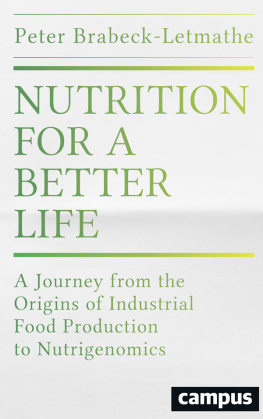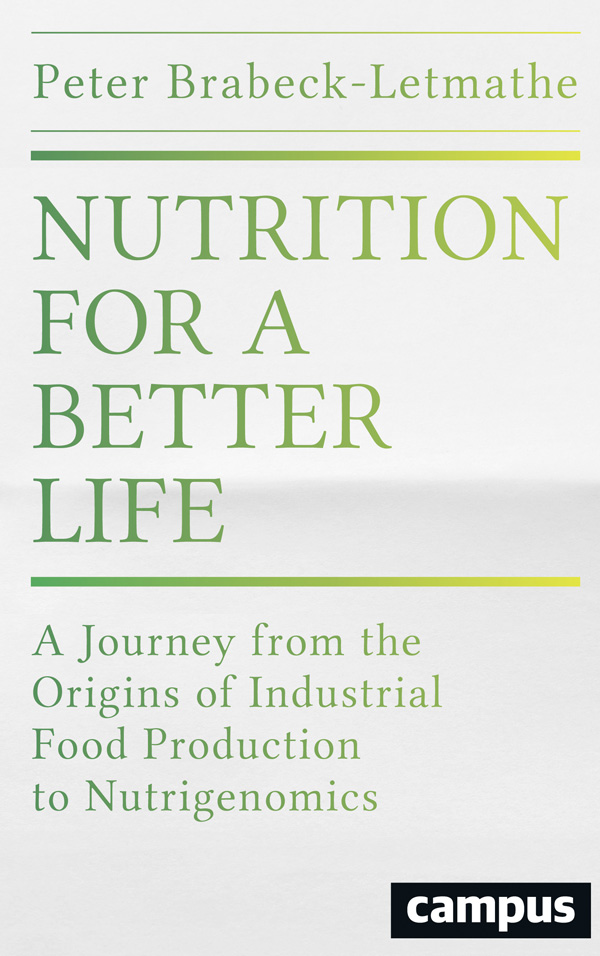Peter Brabeck-Letmathe is Chairman of the Board of Directors at Nestl S.A. He started his career at Nestl in 1968 as salesman and product manager for icecream. From 1970 to 1987 he worked for Nestl in Chile, Ecuador and Venezuela, later transferring to Nestls international headquarters in Vevey, Switzerland, where he took on worlwide responsibility for Culinary Products. In 1992 he was appointed Executive Vice President of Nestl S.A. with worldwide leadership of strategic business groups while simultaneously being in charge of Marketing Consumer and Corporate Communications, and Public Affairs. In 1997 he was elected as a member of the Board of Directors and appointed Chief Executive Officer of Nestl S.A., a position from which he resigned in 2008. Since 2005 he has been Chairman of the Board of Directors at Nestl S.A. Peter Brabeck-Letmathe also serves as Vice Chairman of the Foundation Board of the World Economic Forum in Davos and board member of several companies.
FOREWORD
Prof.Dr.Patrick Aebischer
Less than twenty years ago, the UN Committee on Economic, Social and Cultural Rights (CESCR) defined the right to food. It is the right of every individual alone or in community with others, to have physical and economic access at all times to sufficient, adequate and culturally acceptable food that is produced and consumed sustainably, preserving access to food for future generations. Availability, accessibility, adequacy and sustainability: a rather ambitious definition. And just when we, humans, define the right to food, scientists (notably the then chief UK scientist J. Beddington) predict that by 2030, the demand for food will increase by 50%, for energy by 50%, and for water by 30%, thus creating a perfect storm of global events. Today (2015) 793 million people still go hungrydown from 927 in 2007. We will need innovation, policy, and behavioral changes to fight this storm. Science and technology, universities and businesses must make a significant contribution.
Can the world population of 2030thats 8.5 billion peoplebe fed equitably, healthily and sustainably? The good news is that hunger in its most extreme form has decreased globally from over 1 billion in 19901992, representing 18.9 percent of the worlds population, to 842 million in 20112013, or 12 percent of the population. To meet future food demand, agricultural productivity must increase everywhere, particularly among poor farmers. Meeting this challenge requires continued innovation in food processing and packaging to deliver safe, nutritious, and affordable food. It requires reduction of waste and losses, improved crops tolerant to stress, pollution by smarter use of water, fertilizers and new pesticides. We must do it all. The question is not whether productivity should be raised to address hunger and malnutrition. The question is how to achieve this. Increasing yields alone will not suffice.
We need a greener Green Revolution. The first Green Revolution technological package had a hefty environmental load. Now, a new vista focused on resilience and sustainability, and also wellbeing, is replacingor adding tothe productivist paradigm. Solving this new equation requires integrative science, appropriate technology, farmers knowledge and participation, a performing industry and informed consumers.
Today the world produces enough food for all to go without hunger. Yet hungry many are. On one hand, the source of hunger, is poverty: hungry families do not have the means to buy food. On the other, the culprit is the food system: today, one-third of produced food is eaten by pests or rots away. We need to make agriculture more efficient.
Medicine is moving towards the 4Ps, becoming a predictive, personalized, preventive, participatory medicine. Should farming not benefit from the same approach? Smart farming that integrates local knowledge, cutting edge science, appropriate technology, big data, farmers, smartphones, and businesses. Precision farming that leads to better yields through genotype improvement, exact fertilizer input, proper nutrient ratios, adequate irrigation schedules, geospatial techniques of soil identification, and appropriate mitigation of pests and diseases. Precision farming has the potential to reduce the use of external inputs and thus maximize resource efficiency.
Different forms of farming can and must coexist, our current awe for local organic farming notwithstanding. Strengthening local food systems needs appropriate investments in infrastructure, packaging and processing facilities, and distribution channels, keeping in mind that two out of three humans will live in cities by 2050. Two important strands of agriculturegenetic engineering and organic farmingwill also have to be judiciously incorporated to help feed the growing population in an ecologically balanced manner.
Former UN secretary general Kofi Annan pledges to use digital technology to clear away one obstacle to progress for the hundreds of millions of African smallholder farmers: their profound isolation. Africas smallholders are more than capable of feeding the continent if they are able to use the best agronomic practices. Most have not adopted these improvements, however, because they dont know about them, says Kofi Annan; using digital technology to reach smallholder farmers to help them organize holds out the potential for another agricultural revolution. The first Green Revolution increased productivity; the Green Data Revolution will create a smarter, more flexible and resilient food system.
Precision farming incorporates appropriate knowledge and practices, and the green data revolution: this marriage of high tech and local improvements is one key to success. As a small, telling example, consider the initiative run by Nespresso and the non-profit organization Technoserve in South Sudan. The program enables farmers to set up cooperatives, raise funds, invest in infrastructure, and commercialize their coffee for export. It combines local savoir-faire and top notch technology. In less that two years, it facilitated the creation of three coffee exporting cooperatives in the south of the country, the first commercial coffee to leave South Sudan in over 30 years.
Food security and empowerment of farmers through science is one part of the story. Olivier de Schutter, the special rapporteur to the UN on the right to food, reminds us that the narrative of nutrition changed in a fundamental way when the UN launched its new Sustainable Development Goals in 2015. It moved from a sole focus on undernutrition alleviation and food security to one that includes food quality, equity and food systems, with a central focus on malnutrition in all its forms. Malnutrition is indeed a critical public health problem. It affects the most vulnerable populations: children, the elderly and the sick; individuals afflicted with disease, injuries, in social isolation or with limited resources. Malnutrition affects an estimated 30% to 50% of hospitalized adult patients in the United States. According to the WHO, in 2012, two billion people lacked essential vitamins and minerals.









